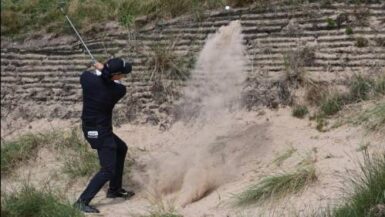Poor Royal Liverpool (or Hoylake to locals): It’s become even more of a football for wise-cracking critics of Open Championship venues than Somber Olde Carnoustie.
Normally Open Championship venues conjure images of hallowed, centuries-old golfing Meccas. There’s the stately architecture of St. Andrews, the romantic beauty of Turnberry, the rugged, heaving, undulating terrain of St. Georges, and the wild winds and cunning routing of Muirfield. There’s Postage Stamps, Road Holes and Principal’s Noses. There’s Barry Burn and Hogan’s Alley and the towering dunes of Royal Birkdale. There’s usual Open Championship venue has majesty.
Royal Liverpool, however, has a bit of an identity crisis. “Go ahead: try to name a famous hole,” asked Sports Illustrated’s Gary Van Sickle in a recent interview.
***Cricket! Cricket! Cricket!***
He’s right. There really isn’t one. In fact, there’s nothing iconic about Royal Liverpool either visually or architecturally. Even the body of water it abuts, Dee Estuary, underwhelms when compared to the churning waters of the Firth of Forth or the mighty Atlantic.
Now name the identifying hazard of the golf course: internal out-of-bounds. The last time the Open was held at Hoylake, Golf Digest’s Ron Whitten derogatorily called it “Royal O.B.” Other American writers have made it the butt of repeated jokes as well. The city of Liverpool has life, the Beatles and great food. It’s easy to get there, it can fit the throngs of fans who will attend the tournament, and it balances the Open Rota with four English venues against four Scottish venues, given that St. Andrews hosts the Open every five years and the rest rotate evenly.
But as far as the quality and memorability of Open Championship venues go, Hoylake is regarded by many as the least interesting and least well-received. With the exception of the stretch of holes from Nos. 9-13 near the estuary, the course is relatively flat.
The English, however, love it. Cybergolf’s Tony Dear went to Liverpool University and played Hoylake nearly every day during his heady, halcyon college days.
“It’s a wonderful course. It plays differently every day with the way the winds can swirl off the Dee Estuary,” he explained. “And many holes can play into a crosswind, making them more difficult still.”
But therein lies the rub. One of the reasons Tiger Woods was able to dismember Hoylake with a 4-iron (a 4-iron!), was because he caught four days of sunshine and no wind.
Talk about an aberration for an Open Championship! As they say in the U.K., “Nae rain, nae wind, nae golf!” Of course some rota courses need less wind than others – Carnoustie, Royal Lytham, Troon and St. Georges, for example, play difficult any time. Others, like Hoylake, which is mostly flat, will rely on wind as a defense to scoring. The year 2006 saw England get its driest spring in nearly a century, followed by Florida weather during Open week. As a result, the golf course played more like an airport tarmac. You’ve heard of a 100-year flood? Well that was 100-year dry.
This year, however, England has seen one of its wettest spring seasons, so now Hoylake has the opposite issue: it’s too green and soft.
“This will be a completely different Open than when Tiger won. Guys may be able to throw darts at the pin,” opined Tour and golf design expert Rodney Zilla. “And that opens the door for everybody.”
That it does. It especially opens the door for more Americans. In fact, it’s almost as though the U.S. Open and Open Championship traded placed this year. Pinehurst was biscuit-brown and particularly fast and firm, playing much like a British Open. Hoylake will certainly play somewhat more like a normal PGA Tour event. There should be plenty of Stars and Stripes on the leaderboard.
It also means that all the riffraff might get invited to the party, as Dan Jenkins likes to say, at least for two, maybe even three days. So look to learn a number of new names, but that’s what watching to Open Championship is all about. How many great foreign players have made their debuts in American fans’ hearts at the Open Championship? Seve, Nick Faldo, Nick Price, Ian Baker-Finch, Ian Woosnam and Darren Clarke for starters . . . but the list is endless.
It’s also as much fun to see the wondrous variety of flags on the leaderboard. As Jenkins also likes to say, the championship opens when the Scotsman tells the Nigerian and the Belgian to play away, please.
Such is the majesty and magic of the Open Championship. It’s almost transportive the way a fabled, hollowed ground materializes from the mists of time, only to disappear again four days later like a reverie, to be reborn almost a decade (or more!) later. Even greener and softer than usual, seaside links golf is still the best golf on the world. When it’s at its best, it’s a wonderful scene.
And besides, with all four of Royal Liverpool’s par-5s reachable in two with irons (unless a gale suddenly materializes, but one’s not forecast), we should see birdies and eagles, and that means excitement, especially at the end of the round at 16 and 18. The R&A deliberately re-sequenced the holes with that purpose in mind; the first hole of the tournament is normally the 17th hole for regular play. They then play everything in order: 17-18-1-2-3, etc.
But ending on 16 also meant there was room for larger gallery stands, while still being near the clubhouse, as well as a closing eagle to win. That would add to Hoylake’s rich history. Roberto DiVicenzo won a claret jug at Hoylake. So did Bobby Jones on his way to the Grand Slam. No, Tiger is not going to win again, but we’ll see a great champion, and come late Sunday afternoon St. Andrews will be on the clock for next year.
Until them, pass the strawberries and cream, pour a cup of Harney & Sons, and throw “Rubber Soul” on the stereo. It’s the de facto world championship of golf, so play away gentlemen. We’ve waited all year for this.
THIS ARTICLE ALSO APPEARED AT CYBERGOLF.COM




